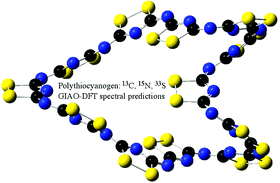Although polythiocyanogen (SCN)x, has been known for a long time, its solid state structure continues to be uncertain and controversial. Reported here are density functional calculations for linear polymers comprising repeating 1,2,4-dithiazole or 1,2,4-thiadiazole rings, an S–S bridged isomer, and a variety of cyclic phyrin-like systems resulting from cyclization of these linear polymers. The computed energies and comparison of GIAO-derived relative magnetic shieldings for the 13C and 15N nuclei with experimental values reported by Woollins and co-workers confirms their assignment of the polymer as based on the 1,2,4-dithiazole ring. It is proposed here that the cyclic forms of this polymer are a better match with experiment than the purely linear forms; the 33S spectra are likely to be the best discriminator for these diverse structures. A number of these cyclic forms are modelled on the conformations of analogous phyrins such as the recently reported dodecaphyrin, and have lemniscular figure-eight or helical topologies which are recognized here as being double or higher twisted Möbius π-conjugated rings. The aromatic character of several forms is dissected using ELF(π) (electron localization) analyses. Based on the propensity of the phyrin rings to form both mono and dinuclear metal complexes, and a specific analogy to a uranylpentaphyrin, it is proposed that a UO2 complex of e.g. a (SCN)2 pentamer might be isolable.

You have access to this article
 Please wait while we load your content...
Something went wrong. Try again?
Please wait while we load your content...
Something went wrong. Try again?


 Please wait while we load your content...
Please wait while we load your content...